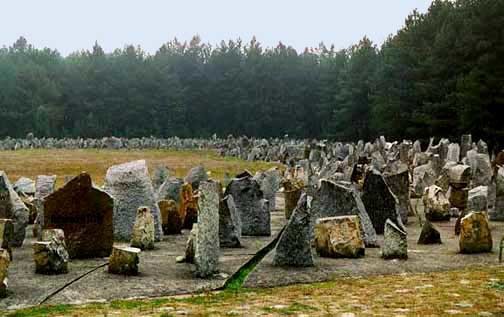Treblinka's Legacy
In roughly two years, an estimated 700,000 lives were lost in a horrific, subhuman way. After the uprising in August 1943, the prisoners managed to destroy a good part of the camp, and it was slowly shut down. Later, the Nazi’s further demolished and destroyed the camp, and felt that they had erased it from history, “They had knocked down the buildings and levelled the earth. They had built a farmhouse and installed a Ukrainian "farmer".
They had planted trees, and - contemporary reports suggest - lupins.” (19) However, they were wrong. Survivors reported the horrors that occurred within the tall trees, and forensic studies uncovered “human remains as they dug into the ground, and on the surface "large quantities of ashes mixed with sand, among which are numerous human bones." (19)
As a way of honoring the lives of those victims of the Third Reich, a memorial was built over the remainders of the camp. The memorial was built between 1959 and 1963 by Polish architects and sculptors (16), Adam Haupt, Franciszek Duszenko and Ftanciszek Strynkiewicz (18). "Fig. 7" and "Fig. 8" are pictures of the memorial nowadays, more than half a century after it was inaugurated.
“The memorial consists of three parts: a symbolic gate to the camp, from which a path, at the edge of the forest, leads towards the ramp where the wagons of victims were unloaded, parallel to the path run train tracks laid out with concrete blocks. Near the ramp, on the right side of the path leading to the gas chambers, stand stones engraved with the names of the countries from which Jews were brought to Treblinka. In the center of the field near the ramp, a monument was erected using granite blocks, whose placement refers to the Wall of Tears in Jerusalem. Beyond the monument, lies the area where bodies were cremated, commemorated with a rectangle of melted black basalt. The third element consists of 17 thousand stones of varying sizes.” (18)
The lack of records made it hard for the memorial to honor all victims, and therefore names are lost in history. Furthermore, in order not to delete history, the Treblinka museum represents the areas where the atrocities took place, such as the burning pit and the crematorium, however the sites itself were destroyed and only symbolic representations remain. The Treblinka memorial contains approximately 17,000 stones, as the ones shown in "Fig. 8", honoring the victims of the camp (18). "Fig. 8" depicts the tall stone cemetery, that according to my tour guide, was built where the most notorious of all gas chamers where located. I remember that when we arrived at the memorial, the stones contained names of countries and regions which had victims in the camp. There is also a stone monument that is larger than the other stones. It is called the “stone monument,” and it is said that it is set where one of the infamous gas chambers once lied.
Roughly 76 years ago, Treblinka’s brief, but deadly history had come to an end. Treblinka might well be the place on earth that the highest number of people died in a short span of time (~2 years), and its lessons will be eternally valuable for us. As the famous quote by George Santayana “those who cannot remember the past are condemned to repeat it,” and not forgetting the atrocities committed during the Holocaust is the only way to avoid a similar event in the future. “History does not repeat itself, but it often rhymes” (Mark Twain).
After the end of the holocaust, the so-called “holocaust deniers” emerged, and this group includes influential people, such as the former President of Iran Mahmoud Ahmadinejad. Repeating and sharing the facts of the holocaust is our obligation as human beings. It does not matter if you are Jewish or not, not forgetting and educating future generations about the holocaust is the only way of avoiding a similar event in the future.
“First they came for the socialists, and I did not speak out—because I was not a socialist.
Then they came for the trade unionists, and I did not speak out— because I was not a trade unionist.
Then they came for the Jews, and I did not speak out—because I was not a Jew.
Then they came for me—and there was no one left to speak for me.” – Martin Niemöller.


